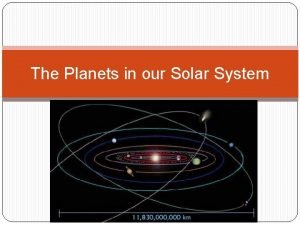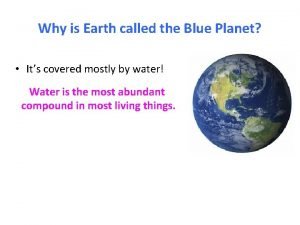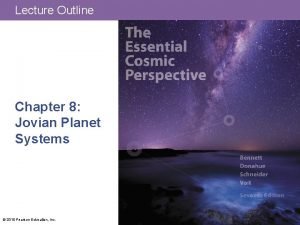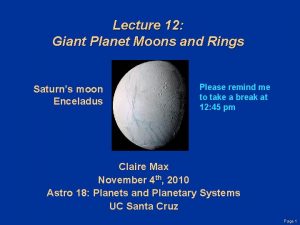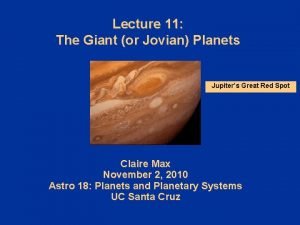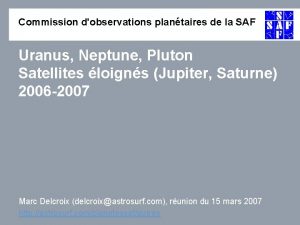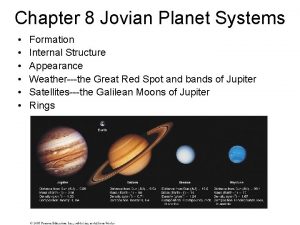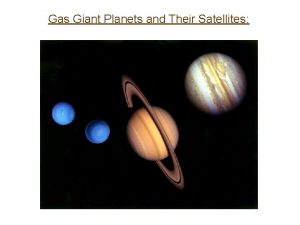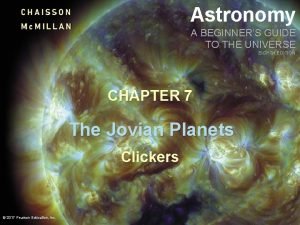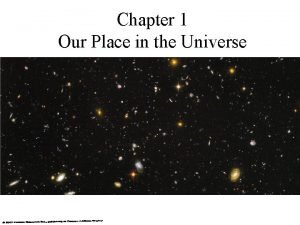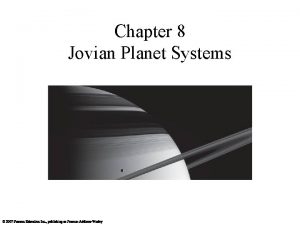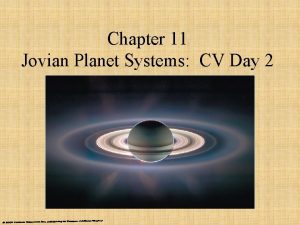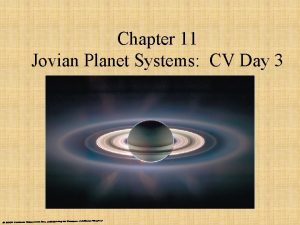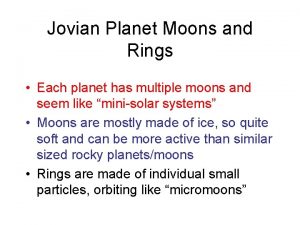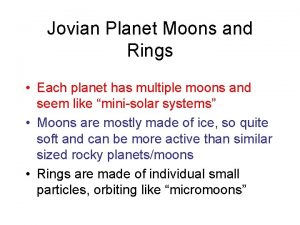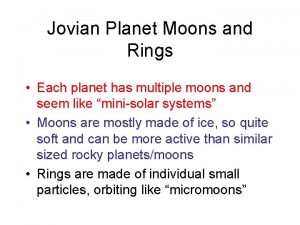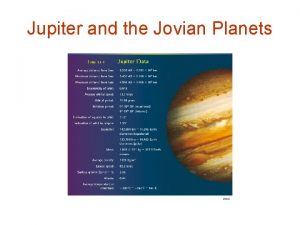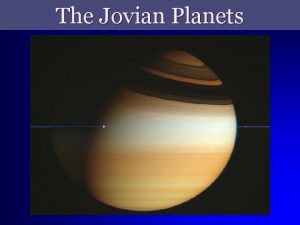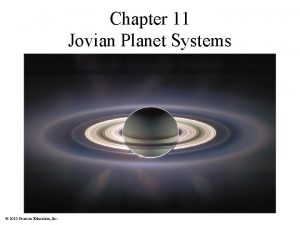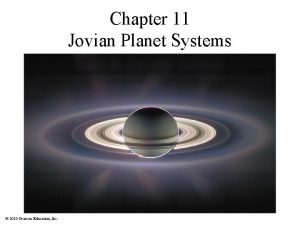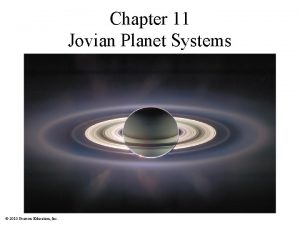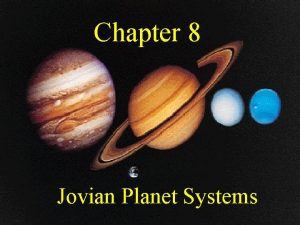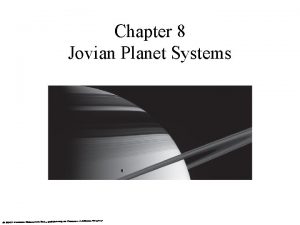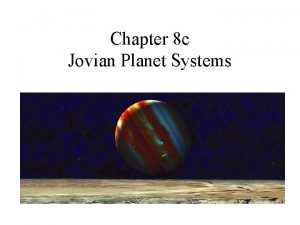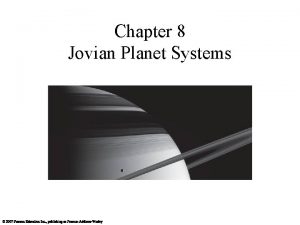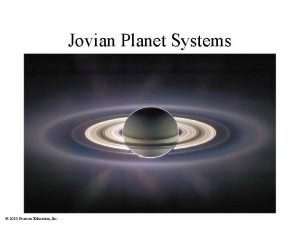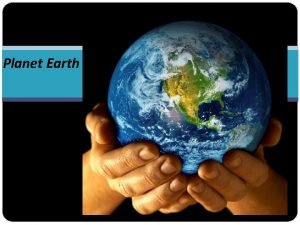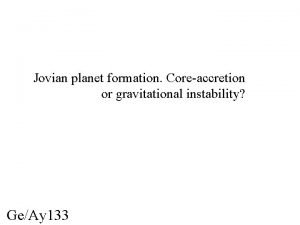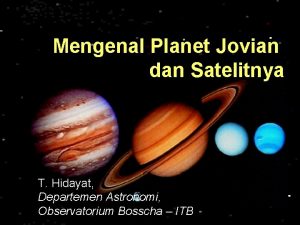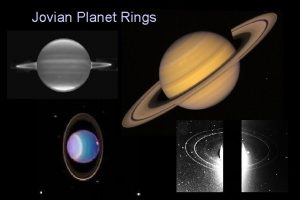Chapter 11 Jovian Planet Systems CV Day 1


























- Slides: 26

Chapter 11 Jovian Planet Systems: CV Day 1

Are jovian planets all alike?

Jovian Planet Composition • Jupiter and Saturn – Mostly H and He gas • Uranus and Neptune – Mostly hydrogen compounds: water (H 2 O), methane (CH 4), ammonia (NH 3) – Some H, He, and rock

Density Differences • Uranus and Neptune are denser than Saturn because they have less H/He, proportionately • But that explanation doesn’t work for Jupiter….

Sizes of Jovian Planets • Adding mass to a jovian planet compresses the underlying gas layers

Sizes of Jovian Planets • Greater compression is why Jupiter is not much larger than Saturn even though it is three times more massive • Jovian planets with even more mass can be smaller than Jupiter

Rotation and Shape • Jovian planets are not quite spherical because of their rapid rotation

Comparing Jovian Interiors • Models suggest cores of jovian planets have similar composition • Lower pressures inside Uranus and Neptune mean no metallic hydrogen

Interiors of Jovian Planets • No solid surface. • Layers under high pressure and temperatures. • Cores (~10 Earth masses) made of hydrogen compounds, metals & rock

Inside Jupiter • High pressures inside Jupiter cause phase of hydrogen to change with depth • Hydrogen acts like a metal at great depths because its electrons move freely

Inside Jupiter • Core is thought to be made of rock, metals, and hydrogen compounds • Core is about same size as Earth but 10 times as massive

Jupiter’s Internal Heat • Jupiter radiates twice as much energy it receives from Sun • Energy probably comes from slow contraction of interior (releasing potential energy)

Internal Heat of Other Planets • Saturn also radiates twice as much energy it receives from Sun • Energy probably comes from differentiation (helium rain) • Neptune emits nearly twice as much energy as it receives, but the source of that energy remains mysterious

What is the weather like on jovian planets? Jupiter’s Great Red Spot • A storm twice as wide as Earth • Has existed for at least 3 centuries

Jupiter’s Atmosphere • Hydrogen compounds in Jupiter form clouds • Different cloud layers correspond to freezing points of different hydrogen compounds NH 3 NH 4 SH • Other jovian planets have H 2 O cloud layers similar to Jupiter’s • Different compounds make clouds of different colors

Jupiter’s colors • Ammonium sulfide clouds (NH 4 SH) reflect red/brown. • Ammonia, the highest, coldest layer, reflects white.

Saturn’s colors • Saturn’s layers are similar, but deeper in and farther from the Sun --- more subdued.

Methane on Uranus and Neptune • Methane gas of Neptune and Uranus absorb red light but transmit blue light • Blue light reflects off methane clouds, making those planes look blue

Jupiter’s Bands White ammonia clouds form where air rises Coriolis effect changes N-S flow to E-W winds Between white clouds we see deeper reddish clouds of NH 4 SH Warmer red bands are brighter in IR

Weather on Jovian Planets • All the jovian planets have strong winds and storms

Jupiter’s Magnetosphere • Jupiter’s strong magnetic field gives it an enormous magnetosphere • Gases escaping Io feed the donut-shaped Io torus

Other Magnetospheres • All the jovian planets have substantial magnetospheres, but Jupiter’s is largest by far

Thought Question Jupiter does not have a large metal core like the Earth. How can it have a magnetic field? a) The magnetic field is left over from when Jupiter accreted b) Its magnetic field comes from the Sun c) It has metallic hydrogen inside, which circulates and makes a magnetic field d) That’s why its magnetic field is weak

Thought Question Jupiter does not have a large metal core like the Earth. How can it have a magnetic field? a) The magnetic field is left over from when Jupiter accreted b) Its magnetic field comes from the Sun c) It has metallic hydrogen inside, which circulates and makes a magnetic field d) That’s why its magnetic field is weak

What have we learned? • Are jovian planets all alike? – Jupiter and Saturn are mostly H and He gas – Uranus and Nepture are mostly H compounds • What are jovian planets like on the inside? – Layered interiors with very high pressure and cores made of rock, metals, and hydrogen compounds – Very high pressure in Jupiter and Saturn can produce metallic hydrogen

What have we learned? • What is the weather like on jovian planets? – Multiple cloud layers determine colors of jovian planets – All have strong storms and winds • Do jovian planets have magnetospheres like Earth’s? – All have substantial magnetospheres – Jupiter’s is largest by far
 Jovian planet
Jovian planet Day 1 day 2 day 3 day 4
Day 1 day 2 day 3 day 4 Why is earth called a blue planet it is because of the
Why is earth called a blue planet it is because of the Day 1 day 2 day 817
Day 1 day 2 day 817 Jovian worlds
Jovian worlds Jupiter's layers
Jupiter's layers Why do jovian planets have rings
Why do jovian planets have rings Why do jovian planets have rings
Why do jovian planets have rings Why are jovian planets bigger than terrestrial
Why are jovian planets bigger than terrestrial Neptune jovian
Neptune jovian Jovian
Jovian Jovian gas giant
Jovian gas giant Saturn is noticeably oblate because
Saturn is noticeably oblate because Sit on the planet chapter 1
Sit on the planet chapter 1 Family sis schoolmax
Family sis schoolmax Oceans apart day after day meaning
Oceans apart day after day meaning Day to day maintenance
Day to day maintenance Physical science chapter 6 review answers
Physical science chapter 6 review answers I don't know about tomorrow
I don't know about tomorrow Act 4 romeo and juliet timeline
Act 4 romeo and juliet timeline Growing day by day
Growing day by day Define seed dormancy
Define seed dormancy Conclusion of seed germination
Conclusion of seed germination Seeds vs spores
Seeds vs spores I live for jesus day after day
I live for jesus day after day Glorious day one day when heaven
Glorious day one day when heaven Day one day one noodle ss2
Day one day one noodle ss2
